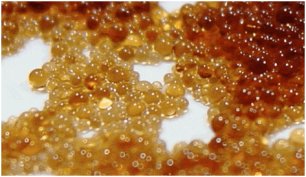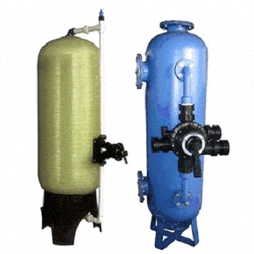Ion-exchange softeners are used extensively in small water systems and individual homes apart from Industry. Ion-exchange resin, exchanges one ion from the water being treated for another ion that is in the resin (sodium is one component of softening salt, with chlorine being the other). Ion Exchange resin exchanges sodium for calcium and magnesium. The following chemical reactions show the exchange process, where R represents Resin, the exchange material.
The presence of certain metal ions in water causes a variety of problems. These ions interfere with the action of soaps. They also lead to build up of limescale, which can foul plumbing and galvanic corrosion.
Conventional water-softening appliances intended for household use depend on an ion-exchange resin in which “hardness ions” – mainly Ca2+ and Mg2+- are exchanged for sodium ions. Ion exchange devices reduce the hardness by replacing magnesium and calcium (Mg2+ and Ca2+) with sodium or potassium ions (Na+ and K+).”
Removal of carbonate hardness
Ca(HCO3)2 + Na2R ——> CaR + 2NaHCO3
Mg(HCO3)2 + Na2R ——> MgR + 2NaHCO3
Removal of non-carbonate hardness:
CaSO4 + Na2R —– > CaR + Na2SO4
CaCl2 + Na2R ——> CaR + CaCl2
MgSO4 + Na2R ——> MgR + Na2SO4
MgCl2 + Na2R ——> MgR + 2NaC1
Ion exchange resins are organic polymers containing anionic functional groups to which the divalent cations (Ca++) bind more strongly than monovalent cations (Na+).
Ion-exchange does not alter the water’s pH or alkalinity. However, the stability of the water is altered due to the removal of calcium and magnesium and slight increase in dissolved solids. For each ppm of calcium removed and replaced by sodium, total dissolved solids increase by 0.15 ppm. For each ppm of magnesium removed and replaced by sodium, total dissolved solids increase by 0.88 ppm.
When all the available Na+ ions have been replaced with calcium or magnesium ions, the resin must be re-charged by eluting the Ca2+ and Mg2+ ions using a solution of sodium chloride. The waste waters eluted from the ion exchange column containing the unwanted calcium and magnesium salts are typically discharged to the sewage system in case of household units.
Ion-Exchange Units
These units resemble pressure filters. The interior is generally treated to protect the tank against corrosion from the salt. The units are normally of the downflow-type, and the size and volume of the units are dictated by the hardness of the water and the volume of treated water needed to be produced between each regeneration cycle. Resin is supported by an underdrain system that removes the treated water and distributes brine evenly during regeneration. Minimum depth of resin should be no less than 24 inches above the underdrain.
Softening Cycle
The length of the softening cycle ends when >5 mg/l of hardness is detected in the effluent Almost all softening units have an alarm on the water meter to indicate when a certain amount of water has passed through the exchange unit. This is done to ensure the required outlet quality.
Backwash Cycle
Once hardness breaks through, or design output between regeneration (OBR) is achieved, the softener must be regenerated. In down-flow units, the resin must first be backwashed to loosen the resin (it becomes compacted by the weight of the water), and to remove any other material that has been filtered out of the water by the resin. The operator needs to apply enough backwash water to expand the resin bed by about 50 percent. Distributors at the top of the unit provide for uniform water distribution and uniform wash-water collection. Underdrains provide uniform distribution of the backwash water on the bottom of the resin.
Regeneration
Concentrated brine is pumped to the unit from the storage basin. Brine is diluted through the injector to a solution containing about 10 percent salt before it is passed through the resin. The time required for regeneration is about 20 to 35 minutes. The brine needs to be in contact with the resin long enough to allow for complete exchange of hardness ions on the resin with sodium ions in the brine. It is better to allow more time than to not allow enough. If the resin is not totally recharged, the next softening run will be short.
Rinse Cycle:
The rinse cycle removes remaining brine from the tank. Normally 10 minutes of Rinse flow equivalent to service flow is sufficient to rinse out excess brine.
Though synthetic softening resins normally last 5 years or so, but certain conditions can cause resin to breakdown earlier. Oxidation by chlorine is probably the most common cause of resin breakdown. When chlorine is used to oxidize iron in the water, the chlorine should be removed before ion exchange.
Secondly Iron will significantly affect the ability of resins to remove hardness ions. Ferrous iron can be oxidized during softening and precipitate out as iron oxide on the resin, and no amount of brine will remove the iron fouling. If iron oxide is formed before ion exchange unit, it can be filtered out by the resin and removed during the backwashing of the unit. Normally if the iron concentration in the source water is high, iron removal is provided ahead of the exchange unit to prevent fouling of the unit.
Turbidity, organic chemicals, and bacterial slimes resins resulting in the loss of some of the resin exchange capacity. The best solution is to remove of the suspended matter with filtration before the softening process.
ADVANTAGES OF ION-EXCHANGE SOFTENING:
Compared with lime-soda ash softening, ion-exchange has certain advantages. It is compact and has a low capital cost. The chemicals used are safer for the operator to handle and operation is much easier. It can be totally automated. Softeners also can be Automatic duplex type to ensure continuous supply of soft water in case of critical application like Boiler Feed etc. Many systems have found ion-exchange to be the most cost effective way to produce quality water for their customers.



